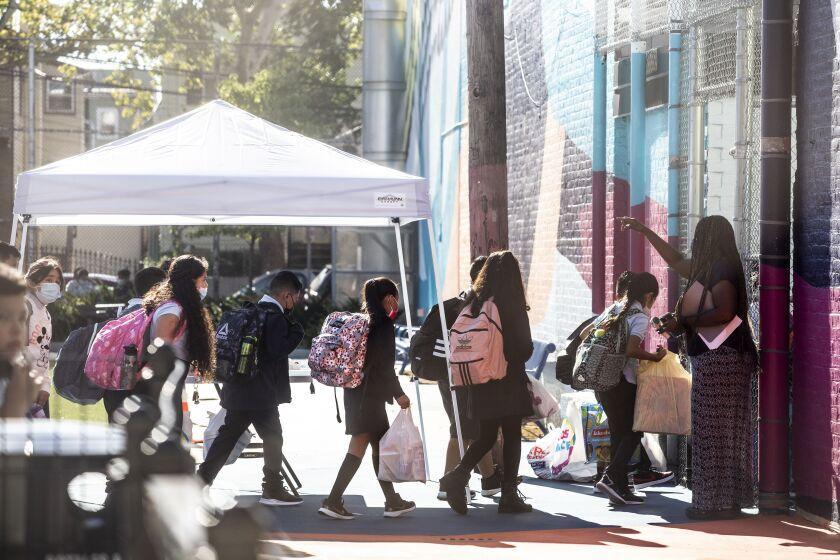New Jersey students fell behind on NAEP math and reading tests known as the “nation’s report card,” but continued to score higher than the national average.
Erica Seryhm Lee for Chalkbeat
New Jersey students fell behind on math and reading tests known as the “nation’s report card” but continued to score higher than the national average despite dismal results laid bare after the pandemic.
Nationally, fourth and eighth grade students who took the National Assessment of Educational Progress, or NAEP, last year saw the largest dips in math scores since 1990, when the exams were first given.
In New Jersey, eighth grade math scores dropped 11 points between 2019 and 2022, while fourth grade scores in the same subject dropped 7 points during the same time frame.
A representative sample of fourth and eighth graders across the state took the exams between January and March, during a school year that saw a continuation of COVID-related disruptions — temporary school closures due to positive cases and students who had to stay home because of quarantine rules — as well as staff and teacher shortages.
Historically, New Jersey students’ average performance in math and reading has been higher than national averages among fourth and eighth graders, according to state data provided by NAEP. But research has already shown that academic progress was derailed between 2019 and 2022.
The NAEP exams, administered periodically by the National Center for Education Statistics, came just weeks after an uptick in positive COVID-19 cases statewide caused by the omicron variant, which prompted some schools to switch to remote learning.
The results from the closely watched NAEP are important because the exams offer a critical snapshot of how students in the Garden State performed in math and reading after the start of the pandemic. The learning disruptions caused by the pandemic affected students in virtually every state and region of the country.
Despite the declines, 38% of fourth grade students in New Jersey scored at or above proficiency level in reading this year, a notable difference from the national average of 32% for fourth graders in the same subject. Similarly, 42% of eighth graders in the state scored at or above proficiency in reading compared to the national average of 29%.
A closer look at New Jersey test scores shows fourth grade reading scores dropped from 227 to 223 between 2019 and 2022. Eighth grade reading scores were flat between 2019 and 2022 staying at 270.
In math, 39% of New Jersey fourth graders scored at the proficient level, compared to 35% of their peers nationally. About one-third — 33% — of eighth graders in the state scored proficient in math compared to 26% of eighth graders nationally.
Fourth grade math scores in the Garden State also dropped from 246 to 239 between 2019 and 2022. Eighth graders saw a bigger dip as math scores declined from 292 to 281 between the same time frame.
Despite averaging higher overall scores compared to other states prior to the pandemic, New Jersey’s scores have shown consistent disparities between rich and poor students, and white and Black or Hispanic students. White students scored higher than Black and Hispanic students this year in math.
“Far too many students in vulnerable communities don’t have access to the education they deserve,” Patricia Morgan, the former executive director of education advocacy nonprofit JerseyCAN said in 2019. “Equity in education must be a primary goal for all of us.”
In 2019, prior to the pandemic, fourth and eighth grade low-income students across the state scored between 26 to 38 points lower than wealthy students in those grades in math and reading, NAEP data show. That year, fourth and eighth grade white students scored 24 to 38 points higher than Black students in math and reading, and 21 to 35 points higher than Hispanic students in those subjects.
Eighth grade Hispanic students in New Jersey scored higher in math this year than Black eighth graders, but lower than their white counterparts. In reading, the state’s eighth grade Hispanic students scored higher — at 254 this year — than their white counterparts at 249. But white fourth graders scored higher than both Black and Hispanic fourth grade students.
Districts look for solutions to learning loss
The national assessments along with state test scores are used to inform education policy and could greatly influence how remaining federal COVID relief money is spent at the state and local level.
With grim results nationwide, district officials across the state say they’re using federal relief money to fund tutoring programs, increase hiring of teachers, and other efforts to address learning loss. But a shallow pool of teacher applicants remains an issue this academic year, said Millville Superintendent Tony Trongone, who spoke at a state Assembly education committee meeting on Oct. 17 about the impact the pandemic and interrupted learning had on student performance academically and behaviorally.
“We have a tutoring program,” Trongone said. “Our issue is getting people to facilitate that program. Teachers are tired.”
Newark Public Schools Superintendent Roger León is also focusing on tutoring for its 38,000 students this year along with Saturday tutoring sessions, SAT prep classes, and after-school programs to help students’ recovery.
Paula White, the executive director for JerseyCAN, said allocating funds to correct services or resources for students is crucial to supporting student recovery.
But as some federal funds may not be distributed on a regular basis, education leaders must think smarter about spending their funds, White said. Districts could resort to contracting consultants or bringing other resources in-house to think creatively about their educational future, she added.
“So, how do we use the funds in ways that set us up for future success, knowing that this is a one time disbursement?” White said. “At this time, it might make sense to engage with providers on a contractual basis, to set systems up that will be sustainable in the long term.”
Parents can also play a role in supporting teachers in school districts during the recovery period by drawing on what worked during remote learning. White said it could be as simple as making sure their child has time to read a book and has a space to do school work. But ultimately, communication between parents and teachers is critical to improving home-school connections.
“Well, I know my child is supposed to be reading 20 minutes every day, so let me make sure they’ve got this blanket, a nice pillow,” White said. “A lot of parents don’t even know what it is that their school expects, because the school has not laid out that expectation.”
Catherine Carrera is the bureau chief for Chalkbeat Newark, covering the city’s K-12 schools with a focus on English language learners. Contact Catherine at ccarrera@chalkbeat.org.
Jessie Gomez is a reporter for Chalkbeat Newark, covering public education in the city. Contact Jessie at jgomez@chalkbeat.org.

